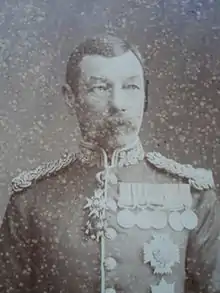50°51′10″N 1°0′46″W / 50.85278°N 1.01278°W
.jpg.webp)

Keydell House[1] was situated in 45 acres (180,000 m2) of land near Lovedean Corner,[2] in the village of Horndean, part of the ecclesiastical parish of Catherington[3] Hampshire from Georgian times until its demolition to make way for houses in 1968.
History
The earliest deed still in existence (for the field "Nine Acres") is dated 1660.[4] The House itself was a three-storey, rectangular mansion with shuttered windows and formal gardens.[5] These eventually became Keydell Nurseries, although the business which still trades under that name moved to a bigger site in 1987.[6] The House had two notable owners: the Victorian actor Edmund Kean;[7] and, most famously, Sir Drury Curzon Drury-Lowe, a full general of the British Army.[8]
Notes
- ↑ Hampshire Register of Historic Parks and Gardens: Revised Deposit HBDWLP (Environment Department, Hampshire County Council, The Castle, Winchester, Hampshire SO23 8UE)
- ↑ Williams' Guide and Timetable to some of the Beauty Spots on the Portsdown and Horndean Light Railway, July 1913
- ↑ Victoria County History A History of the County of Hampshire: Volume 3 Page,W(Ed) 1908 pp 94-101
- ↑ Havant Museum, Local History Collection,Horndean Collection,Vol 4(Keydell): autobiographical notebook of Margaret Strange, Keydell resident 1928-53)
- ↑ Horndean 2000 Singleton,B. (1999, Horndean, Horndean Parish Council
- ↑ Current user of Keydell name
- ↑ Hampshire County Council's page on Horndean Archived 2007-08-06 at the Wayback Machine
- ↑ Lee, Sidney, ed. (1912). . Dictionary of National Biography (2nd supplement). Vol. 1. London: Smith, Elder & Co. p. 846.
 1955
1955 1931 map of site
1931 map of site